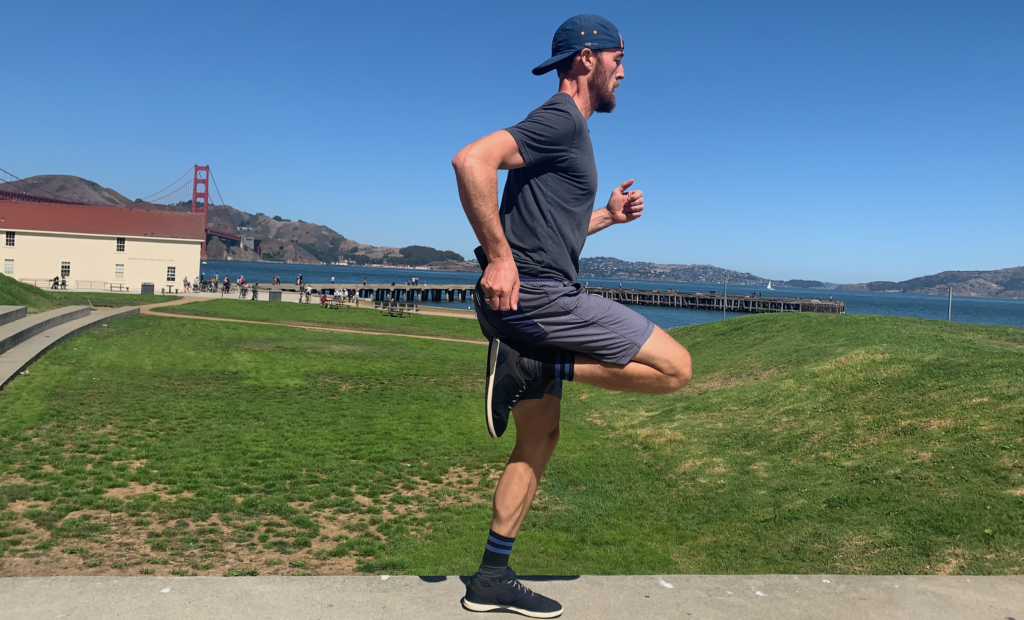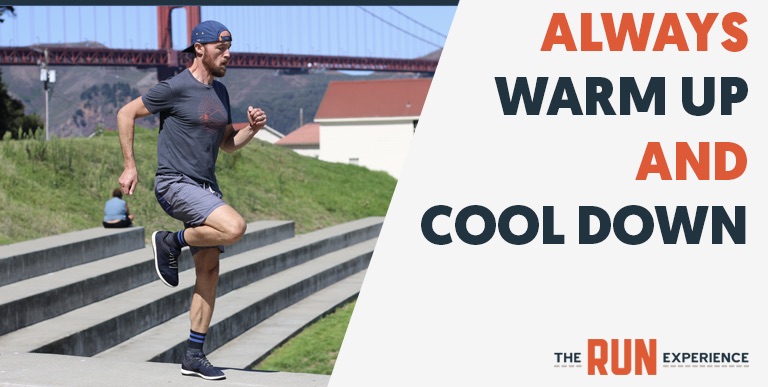Reasons You Should Be Doing a Dynamic Warm-Up Before Every Run
Dynamic warm-ups are vital to running success. Learn how to incorporate dynamic warm-ups into your running routine.

Dynamic warm-ups are vital to running success, so let’s incorporate them into our training plan, shall we?
A proper warm-up reduces your risk of injury, help improve run form, and allow you to run stronger, farther, and faster. But why is that? In this article we’re diving into why dynamic warm ups work, and giving you our four favorite pre-run exercises.
What Are Dynamic Warm-Ups for Running?
Dynamic warm-ups for running involve active, movement-based exercises designed to increase blood flow, elevate muscle temperature, and enhance flexibility. Unlike static stretching, which involves holding a single position, dynamic warm-ups engage multiple muscle groups through continuous movement, aligning the body for optimal performance during a run.
Dynamic warm-ups focus on these key components:
- Movement Specificity: Engage in movements that mimic the biomechanics of running, ensuring relevant muscle groups are activated.
- Gradual Intensity: Start with low-intensity movements, gradually progressing to more vigorous activities as the body warms up.
- Inclusivity: Ensure that the warm-up targets all major muscle groups involved in running, including legs, hips, core, and upper body.
- Duration: Aim for a warm-up duration of approximately 10-15 minutes to ensure adequate preparation without inducing fatigue.
Examples of dynamic warm-up exercises include the following:
- Leg Swings: Holding onto a stable object, swing one leg forward and backward, then side to side, to activate the hips and legs.
- Lunges: Perform forward, backward, and side lunges to engage various leg and hip muscles.
- High Knees: Jog in place, lifting your knees as high as possible with each step, to activate the hip flexors.
- Butt Kicks: While jogging in place, kick your heels up towards your buttocks to warm up the hamstrings.
- Jumping Jacks: Engage in jumping jacks to elevate your heart rate and warm up both the upper and lower body.
- Arm Circles: Perform arm circles in both directions to warm up the shoulders and upper body.
- A-Skips: Skip forward, driving one knee upwards while simultaneously coordinating the opposite arm, to mimic running biomechanics.
- Dynamic Stretching: Include dynamic stretches like walking toe touches and side shuffles to enhance flexibility.
Why Incorporate a Dynamic Warm-Up?
Incorporating a dynamic warm-up into your running routine is not merely a preliminary step but a crucial component that bridges the gap between rest and vigorous activity. Here’s a deeper dive into why dynamic warm-ups are indispensable for runners.
1. Injury Prevention
Dynamic warm-ups are instrumental in mitigating injury risks by enhancing muscle elasticity through increased temperature and ensuring joint mobilization. The activation of stabilizing muscles during these warm-ups helps prevent imbalances and safeguards joints during the subsequent run. This preparation phase ensures that muscles and joints are not shocked from a sudden transition from rest to high activity, thereby reducing the likelihood of strains and sprains.
2. Improved Performance
Incorporating a dynamic warm-up enhances overall running performance by optimizing muscle function, ensuring efficient oxygen delivery to muscles, and activating neuromuscular pathways. The elevation of muscle temperature improves their contraction and relaxation times, while the increased blood flow ensures muscles are well-oxygenated. This, in turn, ensures that the muscles work efficiently and cohesively during the run, supporting enhanced performance.
3. Enhanced Flexibility and Range of Motion
Dynamic warm-ups play a crucial role in improving joint range and muscle length, thereby enhancing flexibility and ensuring optimal stride length and mechanics during running. The movements involved in dynamic warm-ups facilitate a greater range of motion in joints and lengthen muscles, which is pivotal for maintaining an effective and efficient running form. This not only aids in achieving optimal stride length but also ensures that the running mechanics are smooth and efficient.
4. Improved Running Mechanics
Dynamic warm-ups that mimic the biomechanics of running reinforce proper form and posture, ensuring biomechanically efficient movement patterns during the activity. By focusing on running-specific movements during the warm-up, runners can reinforce proper running mechanics and ensure that the body moves in a biomechanically efficient manner during the run. This ensures that each stride is effective and that the body moves harmoniously throughout the run.
5. Adaptation to Running Conditions
Dynamic warm-ups assist the body in acclimatizing to the environmental and terrain conditions, preparing it for specific challenges ahead. Whether adapting to the climate or preparing for varied terrains like hills or trails, a tailored warm-up ensures that the body is prepped and primed for the specific demands it will encounter. This ensures that the transition into the run is smooth and that the body is not shocked by the sudden change in physical demand.
6. Enhanced Recovery Post-Run
Ensuring muscles are warm and joints are lubricated through dynamic warm-ups can mitigate the severity of Delayed Onset Muscle Soreness (DOMS) and facilitate quicker recovery post-run. The preparation of muscles and joints during the warm-up means that they are not subjected to abrupt stress during the run, which can aid in a smoother recovery process. This ensures that the runner is not only safeguarded against post-run soreness but also that the recovery process is expedited.
Best Dynamic Warm-Ups Before Running
Dynamic warm-ups are intended to get the body primed to move more efficiently on your run. Dynamic warm-up drills engage neuromuscular activation, and allow you to focus on your run form in a targeted way before you head out.
If we don’t warm up properly before heading out on that run, it’s like trying to drive with the parking brake engaged. Not a pleasant feeling, and certainly not good for the vehicle!
By incorporating the warm-up drills in this article, you will feel better on and after your runs, maximizing your chances of staying injury-free. And that’s a promise. Let’s dive in to our favorite dynamic warm-up exercises.
#1: Leg Swings
Our first pre-run drill is going to be leg swings. If you can, try to do these balancing on one leg. This will activate your lower calf, ankle, and foot muscles on the standing leg, as they readjust to keep your balance. If that’s a little too much right off the bat, no worries. Find a post or something to hold onto while you do your leg swings.
Starting with a small range of motion, simply swing one leg back and forth, keeping a slight bend in your standing-leg knee. This will slowly start to open up the hamstrings of the swinging leg.
Allow your arms to move in opposition of the leg, counterbalancing the movement. Be sure your back swings carry just as much power as your front swings. Allow these swings to get bigger as you go, getting the blood flow going throughout the body.
Take 20 leg swings on each leg. And if you hold onto something, try to gradually ease off of that over time, so that eventually you can balance on one leg.
#2: Pulling Drill

For this next warm up drill, we’re going to essentially combine high knees and butt kicks. So, rather than pulling your knee up to the front or your toe up to the back, we’re going to pull the heel up the inseam of the opposite leg.
To first get the hang of this one, try several repetitions with just pulling the right leg up, driving the right foot up the left inseam, then try some with the left leg, driving the left foot up the right inseam. Once you have the hang of the motion, you can do both legs alternating. Warm up exercises like this one are great at the beginning of a run, but they’re also great to incorporate in the middle of the run.
No matter when you do it, the pulling drill wakes up the hamstrings, glutes, and hip flexors. It gets the heart rate up enough to keep blood flowing and prepare you for your run, or at least for the rest of your run!
For this drill, try 20 pulls on each leg. If you need some help with counting, listen to Coach Morgan in this video!
#3: Wall Drill
For this next dynamic exercise, your starting position will be about arm’s length from a wall. Place both hands on the wall and lean slightly towards it. Keep a straight diagonal line from your head down through your feet.
For this exercise, you’re going to drive one knee up to about hips’ height, roughly a 90 degree angle. As you drive the knee up, take a small bounce in your standing leg to generate a little bit of power here.
Start slow with this exercise, holding your right knee in the air for about two seconds when you drive it up, then switch sides and repeat the same thing with the left knee. From there, you can build up speed. This helps build the driving force and push-off motion needed for a strong stride. Take about 20 with each leg.
#4: A-Skips
Before we begin this next drill, start with good posture. Stand up straight with your core engaged. Now, A-skips require a bit of “fancy footwork,” so we’re going to have to wake up the nervous system for this one.
Similar to what we did in the wall drill, we’re going to drive one knee up while hopping on other foot. From there, return the driving leg back to the ground, so you have two feet on the ground at the end of a repetition. Then repeat the same with the other leg.
As you get familiar with this movement, try to minimize the time you spend with two feet on the ground. Right as one leg hits the ground, drive the other leg up, engaging the quad and forming about a 90 degree angle with the knee.
Use your arms in opposition here. Again, take roughly 20 repetitions per side.
Final Thoughts on Your Dynamic Warm-Up

Now, these drills are in the above order for a reason! The first movements are more general warm-up movements, aimed at getting the body temperature higher. From there, we work our way into more specific movements, really geared at your run form. These are going to take your jog or run to the next level.
Throw these drills in before your run, and you’ll thank us later! In addition, as we mentioned above, if you’re feeling stale midway through your run, throw some of these drills in during your run. It’s a great way to awaken or re-awaken muscle groups that may have fallen asleep during the monotonous run mechanics.
Lastly, your warm-up routine is just as important as your cool-down. Static stretches are good, but we can do better. For a solid cool-down routine, follow along with the video below.
